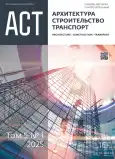Advantages of using textile-reinforced concrete in cantilever structures
- Авторлар: Borisov N.O.1, Stolyarov O.N.1
-
Мекемелер:
- Peter the Great St. Petersburg Polytechnic University
- Шығарылым: Том 5, № 1 (2025)
- Беттер: 81-92
- Бөлім: CONSTRUCTION
- URL: https://bakhtiniada.ru/2782-232X/article/view/308453
- DOI: https://doi.org/10.31660/2782-232X-2025-1-81-92
- EDN: https://elibrary.ru/QMXDMF
- ID: 308453
Дәйексөз келтіру
Толық мәтін
Аннотация
Авторлар туралы
N. Borisov
Peter the Great St. Petersburg Polytechnic University
O. Stolyarov
Peter the Great St. Petersburg Polytechnic University
Әдебиет тізімі
- Kirsanov A. I., Stolyarov O. N. Mechanical properties of synthetic fibers applied to concrete reinforcement. Magazine of Civil Engineering. 2018;(4):15–23. https://doi.org/10.18720/MCE.80.2
- Haas R., Quadflieg T., Stolyarov O. Analysis of reinforcement efficiency and microscopic characterization of glass and carbon roving geometry in prestressed concrete composites. Journal of Composite Materials. 2021;55(23):3293– 3305. https://doi.org/10.1177/00219983211013382
- Stolyarov O., Quadflieg T., Gries T. Characterization of shear behavior of warp-knitted fabrics applied to composite reinforcement. The Journal of the Textile Institute. 2017;108(1):89–94. https://doi.org/10.1080/00405000.2016.1153876
- Quadflieg T., Stolyarov O., Gries T. Influence of the fabric construction parameters and roving type on the tensile property retention of high-performance rovings in warp-knitted reinforced fabrics and cement-based composites. Journal of Industrial Textiles. 2017;47(4):453–471. https://doi.org/10.1177/1528083716652831
- Lu W., Lee W. M. W., Xue F., Xu J. Revisiting the effects of prefabrication on construction waste minimization: a quantitative study using bigger data. Resources, Conservation and Recycling. 2021;170:105579. https://doi.org/10.1016/j.resconrec.2021.105579
- Beckmann B., Bielak Ja., Bosbach S., Scheerer S., Schmidt Ch., Hegger J., Curbach M. Collaborative research on carbon reinforced concrete structures in the CRC/TRR 280 project. Civil Engineering Design. 2021;3(3):99–109. https://doi.org/10.1002/cend.202100017
- Janani R., Lalithambigai N. A critical literature review on minimization of material wastes in construction projects. Materials Today: Proceedings. 2021;37(2):3061–3065. https://doi.org/10.1016/j.matpr.2020.09.011
- Kortmann J. Verfahrenstechnische Untersuchungen zur Recyclingfähigkeit von Carbonbeton = Process engineering investigations into the recyclability of carbon concrete. Springer Vieweg Wiesbaden; 2020. 249 p. (In Germ.) URL: https://www.sci-hub.ru/10.1007/978-3-658-30125-5. http://dx.doi.org/10.1007/978-3-658-30125-5
- Rempel S., Will N., Hegger J., Beul P. Filigrane Bauwerke aus Textilbeton = Filigree structures made of textile-reinforced concrete. Betonund Stahlbetonbau = Concrete and reinforced concrete construction. 2015;110(S1):83–93. (In Germ.) http://dx.doi.org/10.1002/best.201400111
- Bielak J., Schöneberg J., Classen M., Hegger J. Shear capacity of continuous concrete slabs with CFRP reinforcement. Construction and Building Materials. 2022;320:126117. https://doi.org/10.1016/j.conbuildmat.2021.126117
- Zhang M., Deng M. Tensile behavior of textile-reinforced composites made of highly ductile fiber-reinforced concrete and carbon textiles. Journal of Building Engineering. 2022;57:104824. https://doi.org/10.1016/j.jobe.2022.104824
- Stark A., Classen M., Hegger J. Bond behaviour of CFRP tendons in UHPFRC. Engineering Structures. 2019;178(7):148– 161. http://dx.doi.org/10.1016/j.engstruct.2018.10.002
- Kalthoff M., Raupach M., Matschei T. Extrusion and subsequent transformation of textile‐reinforced mortar components – requirements on the textile, mortar and process parameters with a laboratory mortar extruder (LabMorTex). Buildings. 2022;12(6):726. https://doi.org/10.3390/buildings12060726
- Kalthoff M., Raupach M., Matschei T. Investigation into the integration of impregnated glass and carbon textiles in a laboratory mortar extruder (LabMorTex). Materials. 2021;14(23):7406. https://doi.org/10.3390/ma14237406
- Alfani R., Guerrini G. L. Rheological test methods for the characterization of extrudable cement-based materials – A review. Materials and Structures. 2005;38(2):239–247. https://doi.org/10.1007/bf02479349
- Perrot A., Rangeard D., Nerella V. N., Mechtcherine V. Extrusion of cement‐based materials – An overview. RILEM Technical Letters. 2018;3:91–97. http://dx.doi.org/10.21809/rilemtechlett.2018.75
- Li Z., Zhou X. Manufacturing cement-based materials and building products via extrusion: from laboratory to factory. ICE Proceedings Civil Engineering. 2015;168(6):11–16. http://dx.doi.org/10.1680/cien.14.00065
- Kalthoff M., Raupach M., Matschei T. Investigation of rheological test methods for the suitability of mortars for manufacturing of textile-reinforced concrete using a laboratory mortar extruder (LabMorTex). Construction Materials. 2022;2(4):217–233. https://doi.org/10.3390/constrmater2040015
- Du W., Liu Q., Zhou Z., Uddin N. Experimental investigation of innovative composite folded thin cylindrical concrete shell structures. Thin-Walled Structures. 2019;137:224–230. https://doi.org/10.1016/j.tws.2019.01.014
- Chudoba R., van der Woerd J., Schmerl M., Hegger J. ORICRETE: Modeling support for design and manufacturing of folded concrete structures. Advances in Engineering Software. 2014;72:119–127. https://doi.org/10.1016/j.advengsoft.2013.05.004
- Mechtcherine V., Bos F. P., Perrot A., Leal da Silva W. R., Nerella V. N., Fataei S. et al. Extrusion-based additive manufacturing with cement-based materials – Production steps, processes, and their underlying physics: A review. Cement and Concrete Research. 2020;132:106037. https://doi.org/10.1016/j.cemconres.2020.106037
- Mechtcherine V., Nerella V. N., Will F., Näther M., Otto J., Krause M. Large-scale digital concrete construction – CONPrint3D concept for on-site, monolithic 3D-printing. Automation in Construction. 2019;107(3):102933. https://doi.org/10.1016/j.autcon.2019.102933
- Buswell R. A., Leal de Silva W. R., Jones S. Z., Dirrenberger J. 3D printing using concrete extrusion: A roadmap for research. Cement and Concrete Research. 2018;112:37–49. http://dx.doi.org/10.1016/j.cemconres.2018.05.006
- Classen M., Ungermann J., Sharma R. Additive manufacturing of reinforced concrete – Development of a 3D printing technology for cementitious composites with metallic reinforcement. Applied Sciences. 2020;10(11):3791. https://doi.org/10.3390/app10113791
- Meurer M. Classen M. Mechanical properties of hardened 3D printed concretes and mortars-development of a consistent experimental characterization strategy. Materials. 2021;14(4):752. https://doi.org/10.3390/ma14040752
- Lewis W. J. Chapter 6. Tension cables in suspension bridges. A case of form-finding. In: Tension Structures. 2nd edition. ICE Publishing; 2017. P. 101–133. https://doi.org/10.1680/tsfab.61736.101
- Smarslik M., Ahrens M. A., Mark P. Toward holistic tensionor compression-biased structural designs using topology optimization. Engineering Structures. 2019;199(8):109632. http://dx.doi.org/10.1016/j.engstruct.2019.109632
- Stark A., Classen M., Knorrek C., Camps B., Hegger J. Sandwich panels with folded plate and doubly curved UHPFRC facings. Structural Concrete. 2018;19(6):1851–1861. http://dx.doi.org/10.1002/suco.201700288
- Hegger J., Herbrand M., Stark A., Classen M. Betonbau der Zukunft: leicht, filigran und nachhaltig/The future of structural concrete: light, filigree and sustainable. Bauingenieur = Civil Engineer. 2015;90(07-08):337–344. (In Germ.) http://dx.doi.org/10.37544/0005-6650-2015-07-08-61
- Liew A., López D. L., Van Mele T., Block Ph. Design, fabrication and testing of a prototype, thin-vaulted, unreinforced concrete floor. Engineering Structures. 2017;137:323–335. http://dx.doi.org/10.1016/j.engstruct.2017.01.075
Қосымша файлдар








